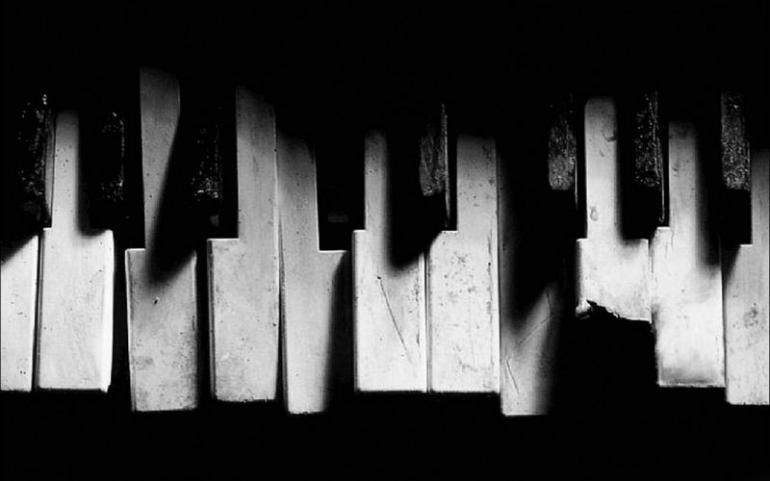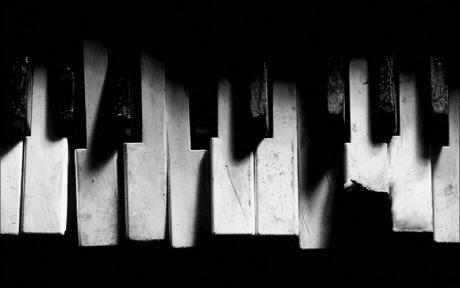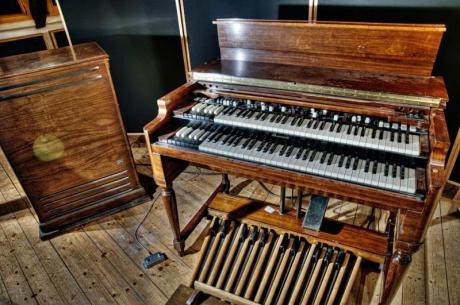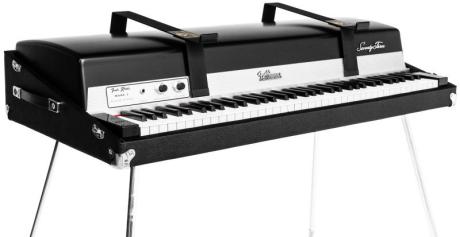Rockové klávesy - První použití elektronických keyboards v rockových kapelách

The first uses of keyboards in rock bands
Hello readers! Welcome back. This month I wanted to talk about the first uses of keyboards in rock bands. Early rock artists like Elvis and Little Richard often used piano on their recordings, but it was in the 1960s that electronic keyboards really started to take center stage in many groups. 1967 seems to be a particularly big year for keyboard rock, as you will see below. Lets take a look at some of these first instruments used in rock bands and some of their earliest usages.
Hammond organ
Invented by clock maker Laurens Hammond in 1935, The Hammond organ was originally intended as a substitute for pipe organ. In the 1950’s it was popularized in jazz by the enigmatic artist, Jimmy Smith. The 1960’s saw the emergence of the Hammond, especially the model B3, organ into rock music. Organist, Felix Cavaliere, made his group, The Young Rascals, a household name when he played his classic organ solo on the classic, Good Luvin’ in 1966.

Another great organ based was the Vanilla Fudge who was greatly influenced by the Young Rascals: there cover of the Motown tune, You Keep Me Hangin’ in 1966 was a huge hit. Lead singer, Mark Stein, had an amazing dramatic Hammond sound that influenced subsequent metal and hard rock bands such as Deep Purple:
Vox Continental
In contrast to the tube, driven sound of the Hammond organ, The Vox Continental, introduced in 1962, is a transistor-based combo organ that has a bright reedy sound. The “Connie”, as it was affectionately known, was designed to be more portable than the Hammond organs. The organ was unfortunately a little delicate would commonly break which caused many artists to choose different organ options for touring.
The traditional 17th-century folk song, House of the Rising Sun, got an amazing lift by the animals in1964 with Alan Price's pulsating Continental organ part. Producer, Mickey Most, said the song was recorded in 15 minutes:
Probably the most famous Vox Continental recording was the Door’s Light My Fire in 1967. Ray Manzarek, the group’s keyboardist said he was very influenced by the inventions of Bach for the intro of the song. The epic “Connie” solo on the track made rock history. The Doors were also the first group to use a modular Moog, which we will discuss below. Check out this amazing cut:
Electric Piano
The Fender Rhodes, the first of the electric pianos we will talk about, has an interesting story. Inventor Harold Rhodes was commissioned by the U.S. military to design the instrument on a very tight budget using spare military parts. The Rhodes Electric Piano has hammers like a regular piano, but instead of strings, the hammers hit metal tines which have pick ups and are then amplified. The instrument evolved from Rhodes’ attempt to manufacture pianos with a soothing sound for shell shocked soldiers returning from World War Two. The first commercially available Rhodes instrument was a cut down version distributed by Fender and called the Piano Bass, the full-size instrument did not appear until 1965.
The Beatles use this instrument extensively in their later years. Keyboard prodigy, Billy Preston, often referred to as the fifth Beatle, made an incredible contribution to the Beatles in 1969 with his solo on the track, Get Back.

The Rhodes electric piano sounds amazing with effects too. It’s very common to add phaser or distortion effect to the sound. I especially like a MXR Phase 90 pedal with a little analog delay.
The Wurlitzer electric piano is another popular electric piano model released in 1954. Instead of tines like the Rhodes, The Wurlitzer uses hammers to strike reeds. The sound of the Wurlitzer is a little more intense than the Rhodes and is often heard with the vibrato effect that is right on the console. Ray Charles loved this instrument and used it on one of his most famous cuts, What’d I Say in 1959. The tune is considered to be one of the first soul songs:
Clavinet
The Hohner Clavinet introduced in 1964 has a distinctive bright staccato sound and appears in many Funk songs from the 1970s. When you take the top cover of a Clav, it actually looks like the neck of a guitar. The pads strike the strings with a hammer on technique known well to all guitarists. Stevie Wonder loved the Clav and used it extensively on songs like Superstition in 1972:
This keyboard is also used with effects a lot. Most players use some sort of wha wha or phaser effect.
Mellotron
The Mellotron was developed and built in Birmingham, England, in 1963. The instrument works by pulling a section of magnetic tape across a head. Different portions of the tape can be played to access different sounds. You could say that the Mellotron was an early sampler. The most popular of the sounds are Flutes and Strings. The tape loops produces a slight warbling sound as they would play which is what gave the instrument it’s characteristic sound. Possibly the best known early usage of this instrument is on the song Strawberry Fields by the Beatles. Here’s a great video of Paul McCartney using the instrument:
Moog
1967 was also a huge year for Robert Moog who introduced the Moog synthesizer at the Monterey Pop Festival in 1967. In 1968 Wendy Carlos recorded Switched on Bach with featured the new analog additive synthesizer. This recording became one of the highest-selling Classical Music recordings of the late 1960s. In a Rock context, the Doors again were ahead of the pack when they used a Modular Moog to modulate Jim Morrison's voice on the 1967 hit Strange Days. Many of the early usages of the Moog synth were made possible by Paul Beaver who was the West Coast Rep of Moog in the United States. Check out the Door’s Strange Days:
Fráze a hudební termíny:
Take center stage: Dostat se do popředí.
Household name: Označíme-li někoho nebo něco takto, znamená to, že se daný člověk či věc těší všeobecnému zájmu. Je těžké najít někoho, kdo by dotyčného neznal.
Combo organ: Ano, jak Brian uvádí, příkladem takových tranzistorových varhan je např. Vox Continental. Proč se ale takovým varhanám říká „combo“? Tvrdí se, že název je odvozen od pojmu „combo band“, který se tehdy hojně používal především v jazzu a znamenal vlastně kapelu s menším počtem hudebníků (tedy nikoliv orchestr nebo big band). Takové skupiny často hrály ve stísněných prostorách a např. Hammondky byly pro ně příliš neskladné. Právě na takové hráče byly „combo organs“ cíleny.
Reedy sound: „Reed“ znamená rákos, ale také plíšek (např. harmoniky). Označíme-li tedy zvuk jako „reedy“, myslíme tím, že je pronikavý a ostrý.
Tines: V případě piana Fender je zvuk generován tak, že kladívko udeří do kovové tyčky, které se říká právě „tine“.
Shell shocked: Takto označíme člověka, který byl (zpravidla dlouhodobě) vystaven nějakému traumatickému vlivu. Příkladem může být válečný veterán, případně člověk, který zažil nějakou katastrofu či nehodu.
Cut down version: „Ořezaná“ či zjednodušená varianta.
Prodigy: Slovník tento výraz zpravidla překládá jako „zázračné dítě“, ale ono o dítě v pravém slova smyslu jít nemusí. Označujeme tak člověka, u kterého se projevuje nějaký talent, který vysoce převyšuje většinu ostatních. Takové nadání se většinou projeví již v útlém věku, proto je pojem často spojován s dětmi, přestože je to (dle mého názoru) nepřesné.
Warbling: Toto slovo znamená de facto „chvění“ zvuku. Brian ho zde použil v souvislosti s Mellotronem, u kterého díky nerovnoměrné rychlosti posunu magnetických pásků právě k podobnému chvění docházelo.
Additive synthesizer: Syntezátor založený na skládání sinusovek, čímž se dosahuje komplexnějšího zvuku. Možná vás to překvapí, ale jedním z nejstarších aditivních syntezátorů jsou Hammondky. Alikvoty, které pomocí táhel přimícháme k základní frekvenci, jsou právě ony zmíněné sinusovky.
Ahead of the pack: Takový člověk má prostě náskok před všemi ostatními.
Modular Moog: Jeden z prvních představitelů tzv. modulárních syntezátorů. Pokud jste u nich chtěli například aplikovat na oscilátor filtr, museli jste patřičné moduly propojit kabelem.
Modulate: Pozor na dvojí význam tohoto slova. „Modulace“ může znamenat změnu tóniny celé skladby, ale i jemnější úpravu signálu. Spadají sem tak i efekty typu chorus, tremolo, phaser a flanger. Také tak můžeme označit modulaci průběhu jedné vlny jiným signálem, jako např. v případě FM syntézy.





